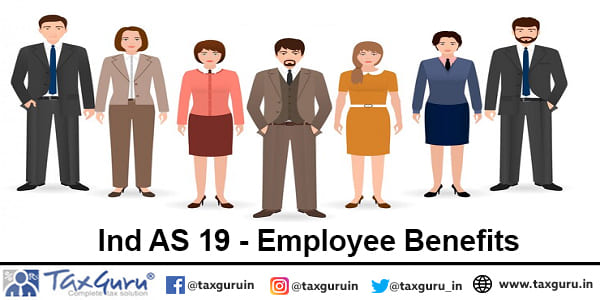Introduction: Ind AS 19 governs the accounting and disclosure practices related to employee benefits, encompassing considerations provided by an entity in exchange for employee services or termination of employment.
Objective: The primary goal of Ind AS 19 is to guide entities in recognizing and disclosing employee benefits. The standard mandates recognition of a liability when an employee renders service for future benefits and an expense when the entity consumes the economic benefit derived from employee services.
Scope: Ind AS 19 applies to all employee benefits, with exceptions for those falling under Ind AS 102, Share-based Payment.
Short-Term Employee Benefits: Short-term employee benefits are those expected to be settled within twelve months after the reporting period, excluding termination benefits. The entity recognizes the undiscounted amount of short-term benefits expected to be paid for services rendered during the accounting period:
- Liability Recognition: Recognize as a liability (accrued expense), deducting any amount already paid.
Example: An employee is entitled to a year-end bonus. The entity accrues the undiscounted amount of the bonus, adjusting for any advance payments.
- Asset Recognition: If the amount paid exceeds the undiscounted amount of benefits, recognize the excess as an asset (prepaid expense) if it leads to a reduction in future payments or a potential cash refund.
- Expense Recognition: Generally recognized as an expense, unless another Ind AS specifies inclusion in the cost of an asset (e.g., Ind AS 2 for inventories or Ind AS 16 for property, plant, and equipment).
Post-Employment Benefits – Defined Contribution Plans
Definition: Post-employment benefits refer to those employee benefits payable after the completion of employment, excluding termination and short-term benefits. These benefits are part of formal or informal arrangements an entity provides for its employees.
Classification: Post-employment benefit plans are categorized into defined contribution plans and defined benefit plans based on the economic substance derived from their principal terms and conditions.

Defined Contribution Plans:
1. Nature:
- In defined contribution plans, an entity makes fixed contributions to a separate fund.
- No legal or constructive obligation exists to pay further contributions if the fund lacks sufficient assets to cover all employee benefits.
2. Risk Distribution:
- Actuarial and investment risks, in essence, fall on the employee rather than the entity.
- The employee’s benefits depend on the contributions made by the entity and, potentially, the employee, as well as investment returns.
3. Recognition of Contributions: When an employee provides service, the entity recognizes the contribution payable to the defined contribution plan:
4. Liability Recognition: Recorded as a liability (accrued expense) after deducting any already paid contributions.
5. Asset Recognition: If contributions already paid exceed the due amount, recognize the excess as an asset (prepaid expense) if it leads to future payment reductions or a potential cash refund.
6. Expense Recognition: Generally recognized as an expense unless other Ind AS mandates inclusion in the cost of an asset (e.g., Ind AS 2 for inventories or Ind AS 16 for property, plant, and equipment).
Example: Suppose an entity contributes a fixed amount to an employee’s retirement fund under a defined contribution plan. If the annual contribution is INR 10,000, and the employee renders services during the year, the entity recognizes INR 10,000 as a liability (accrued expense). If the entity pays INR 12,000, the excess INR 2,000 is recognized as an asset (prepaid expense) if it leads to a reduction in future payments or a potential cash refund.
Post-Employment Benefits: Defined Benefit Plans
Definition: Defined benefit plans under post-employment benefits differ from defined contribution plans. In defined benefit plans:
- The entity commits to providing agreed benefits to current and former employees.
- Actuarial risk (benefits costing more than expected) and investment risk primarily fall on the entity, and if experience deviates from expectations, the entity’s obligation may increase.
Accounting Steps for Defined Benefit Plans:
Step (a) – Determining the Deficit or Surplus:
1. Projected Unit Credit Method:
- Utilizes an actuarial technique, the projected unit credit method, to estimate the ultimate cost of benefits earned by employees in the current and prior periods.
- Involves determining the benefit attributable to the current and prior periods and making estimates (actuarial assumptions) about demographic and financial variables affecting benefit costs.
2. Discounting:
- Discounts the estimated benefit to determine the present value of the defined benefit obligation and the current service cost.
3. Fair Value Deduction:
- Deducts the fair value of plan assets from the present value of the defined benefit obligation.
Step (b) – Determining the Net Defined Benefit Liability (Asset):
- Adjusts the deficit or surplus determined in step (a) for any effect of limiting a net defined benefit asset to the asset ceiling.
- Asset ceiling is the present value of any economic benefit available in the form of refunds from the plan or reduction in future contributions to the plan.
Step (c) – Determining Amounts for Recognition in Profit or Loss:
1. Current Service Cost: Recognizes the cost of benefits earned during the current period.
2. Past Service Cost and Gain or Loss on Settlement: Recognizes any cost or gain/loss related to changes in past service or settlement.
3. Net Interest on the Net Defined Benefit Liability (Asset): Recognizes the net interest on the liability or asset.
Step (d) – Determining Remeasurements:
- Recognizes remeasurements in other comprehensive income, including actuarial gains and losses, return on plan assets (excluding net interest), and changes in the effect of the asset ceiling (excluding net interest).
Example: If an entity promises its employees a pension plan with defined benefits, the entity uses actuarial methods to estimate the present value of future obligations, considering factors like employee turnover, mortality, and financial variables. The resulting liability, adjusted for the asset ceiling, is recognized in the financial statements, along with various components of costs and gains/losses in profit or loss and other comprehensive income.
Accounting Treatment for Defined Benefit Plans Remeasurements:
1. Past Service Cost or Gain/Loss on Settlement:
- Determined by remeasuring the net defined benefit liability (asset) using the current fair value of plan assets and current actuarial assumptions.
- Reflects benefits offered under the plan and changes before and after the plan amendment, curtailment, or settlement.
Example: If an entity amends its pension plan to increase benefits, the resulting increase in liability due to the enhanced benefits is recognized as past service cost. This cost reflects the additional benefits provided to employees.
2. Current Service Cost:
- Determined using actuarial assumptions at the start of the annual reporting period.
- If remeasuring the net defined benefit liability (asset), use the same actuarial assumptions for the remainder of the reporting period.
Example: Assuming an entity has a fixed percentage of salary as the basis for pension accrual, the annual cost for services rendered during the current period is recognized as the current service cost.
3. Net Interest on Net Defined Benefit Liability (Asset):
- Initially determined by multiplying the net defined benefit liability (asset) by the discount rate at the start of the annual reporting period.
- If remeasuring, use the net defined benefit liability (asset) reflecting benefits and plan assets after the amendment for the remainder of the reporting period.
Example: If the net defined benefit liability is $1,000,000 at the beginning of the year, and the discount rate is 5%, the initial net interest recognized would be $50,000.
4. Interest Income on Plan Assets:
- Initially determined by multiplying the fair value of plan assets by the discount rate at the start of the annual reporting period.
- If remeasuring, use plan assets reflecting the net defined benefit liability (asset) for the remainder of the reporting period.
Example: If plan assets are $800,000 at the beginning of the year, and the discount rate is 6%, the initial interest income on plan assets would be $48,000.
5. Interest on the Effect of the Asset Ceiling:
- Part of the total change in the effect of the asset ceiling.
- Initially determined by multiplying the effect of the asset ceiling by the discount rate at the start of the annual reporting period.
- If remeasuring, consider changes in the effect of the asset ceiling for the remainder of the reporting period.
Example: If the effect of the asset ceiling is $100,000 at the beginning of the year, and the discount rate is 4%, the initial interest on the effect of the asset ceiling would be $4,000.
6. Other Long-Term Employee Benefits: Other long-term employee benefits encompass all employee benefits excluding short-term benefits, post-employment benefits, and termination benefits. Unlike post-employment benefits, the standard for other long-term benefits allows for a simplified method of accounting without recognizing re-measurements in other comprehensive income.
Example: Suppose an entity provides long-term disability benefits to employees. The entity may use a simplified method to account for these benefits without the level of measurement precision required for post-employment benefits.
7. Termination Benefits: Termination benefits are provided in exchange for terminating an employee’s employment, either due to the entity’s decision or the employee’s acceptance of benefits in exchange for termination. The standard mandates the recognition of a liability and expense for termination benefits at the earlier of the following dates:
1. When the entity cannot withdraw the offer of benefits anymore.
-
- If the entity makes an offer of termination benefits, once it becomes irrevocable, the liability and expense are recognized.
2. When the entity recognizes costs for a restructuring within the scope of Ind AS 37 involving termination benefits.
-
- If the termination benefits are part of a restructuring within the scope of Ind AS 37, recognition occurs when costs for the restructuring are recognized.
Example: If a company decides to downsize and offers severance packages to employees, the liability for termination benefits is recognized when the offer becomes irrevocable or when the restructuring costs are recognized under Ind AS 37.
Conclusion: Ind AS 19 provides a comprehensive framework for accounting and disclosing employee benefits, ensuring transparency and consistency across entities. It mandates the recognition of liabilities and expenses as employees render services, contributing to more accurate financial reporting. By distinguishing between defined contribution and benefit plans, Ind AS 19 also clarifies the distribution of actuarial and investment risks. This standard not only facilitates better financial decision-making but also enhances stakeholders’ understanding of an entity’s commitment to its employees. Through meticulous compliance with Ind AS 19, entities can effectively manage and disclose their employee benefit obligations, reflecting their financial health and operational stability accurately.





